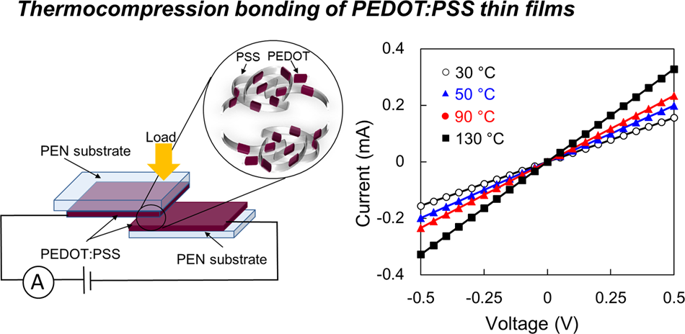Our official English website, www.x-mol.net, welcomes your
feedback! (Note: you will need to create a separate account there.)
Thermocompression bonding of conductive polymers for electrical connections in organic electronics
Polymer Journal ( IF 2.3 ) Pub Date : 2019-12-18 , DOI: 10.1038/s41428-019-0294-0 Kazuki Maeda , Masashi Nitani , Mayumi Uno
Polymer Journal ( IF 2.3 ) Pub Date : 2019-12-18 , DOI: 10.1038/s41428-019-0294-0 Kazuki Maeda , Masashi Nitani , Mayumi Uno

|
The thermocompression bonding of conductive polymer films was investigated to achieve a flexible wiring and packaging technique for organic and flexible electronics. Conductive polymer poly(3,4-ethylenedioxythiophene) polystyrene sulfonate (PEDOT:PSS) films were successfully bonded together by thermocompression even at rather low temperatures of 50–100 °C, especially through surface activation treatment using ultraviolet light irradiation. After thermocompression, the PEDOT:PSS films maintained their ohmic electrical conductivity even though the adhered interface had a contact resistivity of less than 1.3 Ω cm 2 . To examine the applications to electrical bonding, PEDOT:PSS patterns were fabricated on polyethylene naphthalate (PEN) substrates, and the bonding force after thermocompression was investigated. The adhesiveness of bonding was highly improved, and the films were strongly adhered at a bonding temperature of ~100 °C, which was lower than the glass transition temperature ( T g : 160 °C) of the PEN substrates. X-ray photoelectron spectroscopy (XPS) analysis of both the PEDOT:PSS and PEN surfaces and the attenuated total reflectance FT-IR (ATR-FT-IR) for the PEN surfaces indicated that the oxidized species of alcohol and carboxylate were generated after the surface activation process. These chemical species can form hydrogen bonds or covalent bonds that provide robust bonding interfaces. The thermocompression bonding of conductive polymer films was investigated to achieve a flexible wiring and packaging technique for flexible electronics. Conductive polymer poly(3,4-ethylenedioxythiophene) polystyrene sulfonate (PEDOT:PSS) films were successfully bonded together by thermocompression, especially through surface activation treatment using ultraviolet light irradiation. After thermocompression, the PEDOT:PSS films maintained their ohmic electrical conductivity even through the adhered interface. The surface state analysis of the PEDOT:PSS indicated that the oxidized species were generated after the surface activation process. These chemical species can interact each other and provide robust bonding interfaces.
中文翻译:

用于有机电子电气连接的导电聚合物的热压粘合
研究了导电聚合物薄膜的热压粘合,以实现有机和柔性电子产品的柔性布线和封装技术。导电聚合物聚(3,4-亚乙基二氧噻吩)聚苯乙烯磺酸盐(PEDOT:PSS)薄膜即使在 50-100°C 的相当低的温度下也能通过热压成功粘合在一起,特别是通过使用紫外线照射进行表面活化处理。热压后,PEDOT:PSS 薄膜保持其欧姆导电性,即使粘附界面的接触电阻率小于 1.3 Ω cm 2 。为了检查电粘合的应用,在聚萘二甲酸乙二醇酯 (PEN) 基材上制造了 PEDOT:PSS 图案,并研究了热压后的粘合力。粘合的粘合性得到了极大的提高,薄膜在~100°C的粘合温度下牢固粘合,该温度低于PEN基板的玻璃化转变温度(Tg:160°C)。PEDOT:PSS 和 PEN 表面的 X 射线光电子能谱 (XPS) 分析以及 PEN 表面的衰减全反射 FT-IR (ATR-FT-IR) 表明,醇和羧酸盐的氧化物质是在表面活化过程。这些化学物质可以形成氢键或共价键,提供牢固的键合界面。研究了导电聚合物薄膜的热压粘合,以实现柔性电子产品的柔性布线和封装技术。导电聚合物聚(3,4-乙撑二氧噻吩)聚苯乙烯磺酸盐(PEDOT:PSS) 薄膜通过热压成功地粘合在一起,特别是通过使用紫外线照射的表面活化处理。热压后,PEDOT:PSS 薄膜即使通过粘附界面也能保持其欧姆导电性。PEDOT:PSS 的表面状态分析表明氧化物质是在表面活化过程后产生的。这些化学物质可以彼此相互作用并提供牢固的键合界面。PSS 表明氧化物质是在表面活化过程后产生的。这些化学物质可以彼此相互作用并提供牢固的键合界面。PSS 表明氧化物质是在表面活化过程后产生的。这些化学物质可以彼此相互作用并提供牢固的键合界面。
更新日期:2019-12-18
中文翻译:

用于有机电子电气连接的导电聚合物的热压粘合
研究了导电聚合物薄膜的热压粘合,以实现有机和柔性电子产品的柔性布线和封装技术。导电聚合物聚(3,4-亚乙基二氧噻吩)聚苯乙烯磺酸盐(PEDOT:PSS)薄膜即使在 50-100°C 的相当低的温度下也能通过热压成功粘合在一起,特别是通过使用紫外线照射进行表面活化处理。热压后,PEDOT:PSS 薄膜保持其欧姆导电性,即使粘附界面的接触电阻率小于 1.3 Ω cm 2 。为了检查电粘合的应用,在聚萘二甲酸乙二醇酯 (PEN) 基材上制造了 PEDOT:PSS 图案,并研究了热压后的粘合力。粘合的粘合性得到了极大的提高,薄膜在~100°C的粘合温度下牢固粘合,该温度低于PEN基板的玻璃化转变温度(Tg:160°C)。PEDOT:PSS 和 PEN 表面的 X 射线光电子能谱 (XPS) 分析以及 PEN 表面的衰减全反射 FT-IR (ATR-FT-IR) 表明,醇和羧酸盐的氧化物质是在表面活化过程。这些化学物质可以形成氢键或共价键,提供牢固的键合界面。研究了导电聚合物薄膜的热压粘合,以实现柔性电子产品的柔性布线和封装技术。导电聚合物聚(3,4-乙撑二氧噻吩)聚苯乙烯磺酸盐(PEDOT:PSS) 薄膜通过热压成功地粘合在一起,特别是通过使用紫外线照射的表面活化处理。热压后,PEDOT:PSS 薄膜即使通过粘附界面也能保持其欧姆导电性。PEDOT:PSS 的表面状态分析表明氧化物质是在表面活化过程后产生的。这些化学物质可以彼此相互作用并提供牢固的键合界面。PSS 表明氧化物质是在表面活化过程后产生的。这些化学物质可以彼此相互作用并提供牢固的键合界面。PSS 表明氧化物质是在表面活化过程后产生的。这些化学物质可以彼此相互作用并提供牢固的键合界面。











































 京公网安备 11010802027423号
京公网安备 11010802027423号